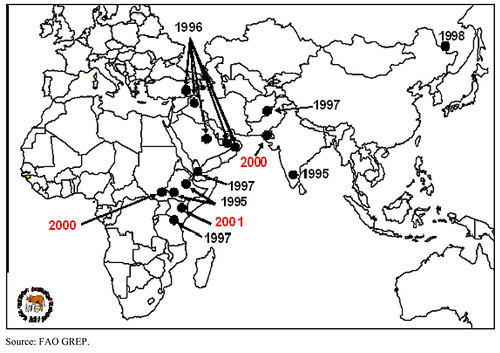Last known occurrences of rinderpest since 1995. IFPRI Discussion Paper 00923, November 2009, ‘The Global Effort to Eradicate Rinderpest’ by Peter Roeder and Karl Rich, 2020 Vision Initiative, a paper prepared for a project on Millions Fed: Proven Successes in Agricultural Development (www.ifpri.org/millionsfed) (illustration credit: FAO GREP).
Jeffrey Mariner, former advisor for special action areas to the Pan-African Rinderpest Campaign and current senior scientist at the International Livestock Research Institute (ILRI), based in Kenya, is one of several authors of a paper published in the current issue of Veterinary Record on the subject of the rising importance of building a systematic program to eradicate a goat disease known as ‘peste des petits ruminants’ (PPR), or goat plague.
The editorial in the Veterinary Record explains why goat plague is replacing cattle plague among the world’s verterinary researchers.
‘This week saw a landmark in the history of the veterinary profession and, more specifically, its management of disease threats to food security. The Food and Agriculture Organization of the United Nations (FAO) announced on June 28, 2011 that its member countries had passed a resolution declaring rinderpest to have been eradicated globally, building on an announcement in May that the World Organisation for Animal Health (OIE) at its General Session had passed a resolution to the effect that all countries in the world had been formally accredited as free from rinderpest.
‘These events mark the fact that the virus is no longer present in any of its natural hosts on this planet. No longer is it a cause of disease or a constraint to international trade. What is not generally appreciated is that the eradication of rinderpest has yielded benefits that surpass virtually every other development programme in agriculture, and will continue to do so into the future. For example, a preliminary study in Chad shows that over the period 1963 to 2002, each dollar spent on rinderpest eradication led to a benefit of at least US $16, a conservative estimate that only takes into account the benefits from reduced cattle deaths and resulting herd growth, without including secondary impacts on the economy as a whole (Rich and others 2011).
‘Building on the dramatic success of the global effort to eradicate rinderpest we now wish to draw attention to a related but significantly different morbillivirus disease, peste des petits ruminants (PPR), also known variously as goat plague, pseudorinderpest, pneumoenteritis and kata. A comprehensive review of the disease by research scientists at the Institute for Animal Health Pirbright laboratory (IAH Pirbright) is published in this issue of Veterinary Record and explains the scientific basis for considering eradication (Baron and others 2011).
‘Until relatively recently PPR was considered to be a parochial disease of west Africa; however, its range is now recognised to affect most of sub-Saharan Africa as well as a swathe of countries from Turkey through the Middle East to south Asia with recent alarming extensions into north Africa, central Asian countries and China. Capable of causing very high mortality in susceptible goat herds and sheep flocks, PPR exerts a major economic impact on farmers and their families dependent on small ruminants. There is a growing appreciation that PPR is a most serious constraint to the livelihoods of farming families and to food security in affected countries and that its control warrants significant investment. An additional concern is the lethal nature of PPR infection in wildlife species, many of which are endangered or threatened, including gazelles and mountain caprines. Until recently, losses were apparently restricted to extensive wildlife collections in the Middle East but now outbreaks are being recognised in free-ranging species such as the Sindh ibex (Capra aegagrus blythi) in Pakistan. It is probable that many cases of wildlife disease have passed unnoticed in remote locations.
‘Encouraged by what has been achieved with rinderpest and an understanding that the factors that marked rinderpest eradication as feasible apply equally to PPR, we believe that a global programme for the total eradication of PPR should be established as an international undertaking without delay. The FAO has recently hosted a number of symposia and workshops at which participating chief veterinary officers have unanimously requested such a global initiative against PPR. . . .’
Read the whole editorial in Veterinary Record: Rinderpest eradicated; what next?, 2011: 169. DOI:10-11 doi:10.1136/vr.d4011
Read a paper by Peter Roeder and ILRI scientist Karl Rich, The global effort to eradicate rinderpest, IFPRI Discussion Paper 00923, November 2009, prepared for the project on Millions Fed: Proven Successes in Agricultural Development.

